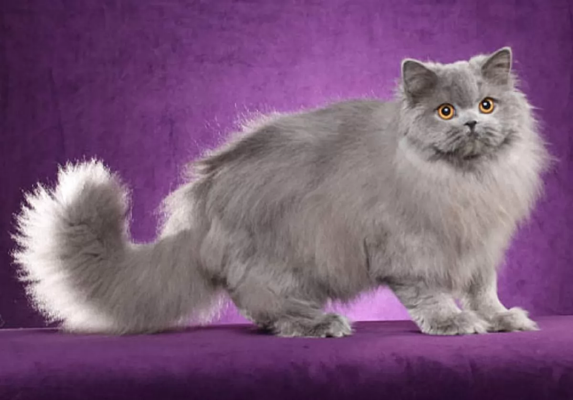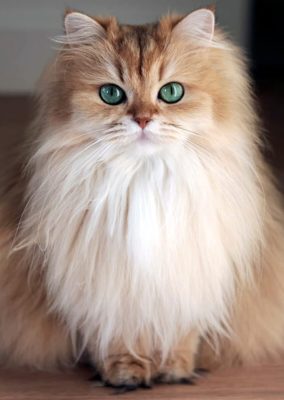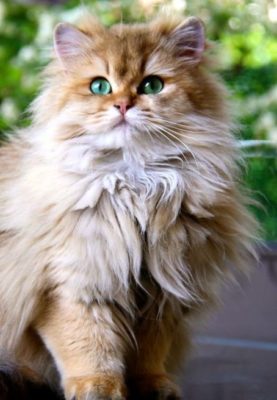British Longhair

The British Longhair cat is not capricious and is an unproblematic pet for people who prefer peace and quiet. Experienced breeders note that lowlanders are more malleable than their short-haired counterparts. Representatives of the breed feel comfortable alone. However, you should not leave the pet for a long time without its attention.
Table of Contents
Breed Information
| Origin | United Kingdom |
| Size | 28-35 cm |
| Weight | Males 5-7 kg Females 3-5 kg |
| Fur Type | Semi-long-haired |
| Color | Anyone |
| Lifestyle | Outdoors, indoors |
| Lifespan | 14-20 years |
| FIFe Classification | – |
| WCF Classification | Group 2: “Semi-long-haired” Breed designation – BLH |
| TICA Classification | BL |
| Group | Long-haired cats |
| Price | $800-1200 |
Breed Photos
Origin History
The tale of the British Longhair cat unfurls with a deliberate entwining of its short-haired progenitors with the luxurious Persians. This crossbreeding venture embarked by breeders had a vision — to diversify the color spectrum and amplify the stature inherent in the British feline lineage. Initially, the birth of the first kittens was cast under a shadow of crossbreeding misadventure, yet, as time laced through, they emerged as a new, invaluable breed, garnering admiration.
The British Longhair cat, with its plush coat and majestic demeanor, now commands a cherished space not just within the heart of the UK but has pawed its mark across the globe. Despite the absence of an official emblem of recognition in the world’s breed registries, the allure of the British Longhair remains undeterred. Its burgeoning popularity among the connoisseurs of furry companions continues to soar, carving a niche of its own in the tapestry of feline breeds.
Appearance
When one gazes upon a British Longhair, the external resemblance to its short-haired counterparts is unmistakable, yet, it’s the luxuriant fur that sets them apart, draping elegantly over their sturdy form. This breed presents a visage of roundness, with a large to medium-sized muzzle that’s further accentuated by whimsically rounded vibrissae. Nestled within are their captivating eyes, whose iris color often mirrors that of their coat, with the exception of the silver or gray-hued ones, who flaunt a rich green gaze.
As one travels down from the head, the neck of the British Longhair might appear abbreviated, especially as they age, seeming to meld seamlessly with their body, lending an appearance as if it scarcely exists. The ears, modest in size, bear soft tips slightly rounded, seeming to fan out gently to the sides, framing their face with a sweet earnestness.
The structure of the British Longhair is one of stockiness, a robust physique standing on thick paws, a testament to their sturdy lineage. Their legs, of a medium length, support their muscular body with a sturdy grace. The tail follows suit with the rest of their physique, thick and ending in a soft roundness, swaying gently as they move.
Color-wise, the British Longhair cat dons a palette akin to the British Shorthairs, yet it’s their coat that’s a marvel. Resilient and dense, the fur provides a plush covering, offering a tactile delight to those who stroke it. Often, a charming downy fur adorns their collar and pant legs, adding a touch of whimsy to their regal bearing.
Their appearance is a blend of robustness and grace, with every curve and tuft of fur narrating tales of its rich lineage, making the British Longhair a breed that’s visually enchanting and endearing to the beholder.
Character
The British Longhair cat epitomizes a temperament that’s amiable and unassuming, making them a delightful companion for individuals who treasure serenity. Unlike many other breeds, they are far from capricious, and their ease of care makes them an attractive choice for first-time cat owners. Experienced breeders often emphasize how the British Longhair, often referred to as the lowlanders, exhibit a malleability that sets them apart from their short-haired counterparts. They harbor a serene disposition, feeling at ease even when left to their own devices, although like any pet, they too seek the warmth of interaction and should not be left unattended for prolonged periods.
Their playful essence shines through, whether in the company of humans or when left alone with a spread of toys. They embrace playfulness but as they mature, a certain phlegmatic trait surfaces, embodying a calm seldom disrupted. This poised demeanor extends to their interactions with children and other animals, showcasing a remarkable tolerance that’s heartwarming to witness. However, the cornerstone to fostering a harmonious relationship, especially with dogs, lies in early socialization. This eases them into forming bonds that can last a lifetime.
While the British Longhair is a symbol of love and gentleness, they do have their boundaries. They are not fond of overly tight hugs or rough handling. Should they find themselves in the grasp of a too-tight hug, they might resort to a soft scratch or a hiss to communicate their discomfort. Their way of asserting their boundaries is gentle yet firm, teaching a lesson in respecting personal space.
British Longhairs are not just pets; they are companions exuding a subtle elegance and a calm demeanor. Their loving nature, blended with a dash of independence, makes them an ideal pet for those seeking a low-maintenance yet engaging furry companion. Each interaction with them is a step into a world of gentle affection, teaching the beauty of a calm and loving companionship.
Care
The British Longhair, often referred to as ‘Lowlanders’, are epitomes of cleanliness. Ensure a timely refresh of their litter and a clean sweep of their food and water bowls to keep them content. A scratching post is a must to divert their natural scratching instinct away from your cherished furniture. Fresh air is a boon, so a secured outdoor space or a safely netted balcony corner is ideal for their leisure.
Their luxurious coat, though not prone to tangling, yearns for a weekly combing session, with an uptick during heightened shedding phases. A routine claw clipping every two to three weeks for forelegs and monthly for hind legs keeps them well-groomed. Attending to their eyes and ears as needed, removing any mucous or debris, completes the hygiene checklist, ensuring your British Longhair remains a picture of health and elegance.
Education
Lowlanders are hard to re-educate. Helpful habits and good manners must be instilled from an early age. British Longhairs get used to the litter box quickly. Put several cat litter boxes in different rooms because the little kitten may forget where the litter box is.
Do not shout at your pet or raise your hand. British Longhair has a delicate mental organization; you can shake the cat’s psyche. Lowlanders love praise. Give the kitten a treat as encouragement for achievement. It is the best incentive for good behavior.
Common Diseases
The British Longhair, with its robust immunity, often enjoys a long, healthy life, with proper care enabling them to live up to two decades. However, even these sturdy felines are not entirely exempt from health issues. Here’s a closer look at some common ailments:
- Hepatic Polycystic Disease: This genetic disorder affects the liver, causing fluid-filled cysts to form. Early detection and management can help mitigate its impact on your cat’s health.
- Obesity: A sedentary lifestyle or overfeeding can lead to obesity, a concerning condition as it opens the door to other health issues like diabetes and arthritis. A balanced diet and regular exercise are crucial for maintaining a healthy weight.
- Hypertrophic Cardiomyopathy (HCM): HCM is a common heart disease among cats, characterized by the thickening of the heart muscles. Regular veterinary check-ups can help catch and manage this condition early.
- Diabetes: Often linked to obesity, diabetes requires a strict dietary regimen and possibly insulin injections to manage.
- Arthritis: As your British Longhair ages, arthritis might set in, making movement painful. Weight management and joint supplements can aid in alleviating symptoms.
Careful monitoring of your British Longhair’s diet, regular exercise, and routine veterinary check-ups can significantly contribute to a healthy, fulfilling life, allowing your feline companion to remain by your side for many cherished years.
Nutrition
A balanced diet is crucial for your British Longhair’s overall health. Whether you opt for commercial cat food, homemade meals, or a blend, ensuring a nutritional balance is key. Commercial food often has essential micronutrients, while a natural diet should encompass:
- Fermented milk and dairy products for digestive health.
- Lean meats like lamb, turkey, or beef for protein.
- By-products for additional nutrients.
- Eggs for protein, but moderation is key.
While milk is beneficial for kittens, adult cats often lose the ability to digest lactose. Hence, it’s typically avoided. Eggs are nutritious but should be given in moderation to prevent any adverse reactions.



